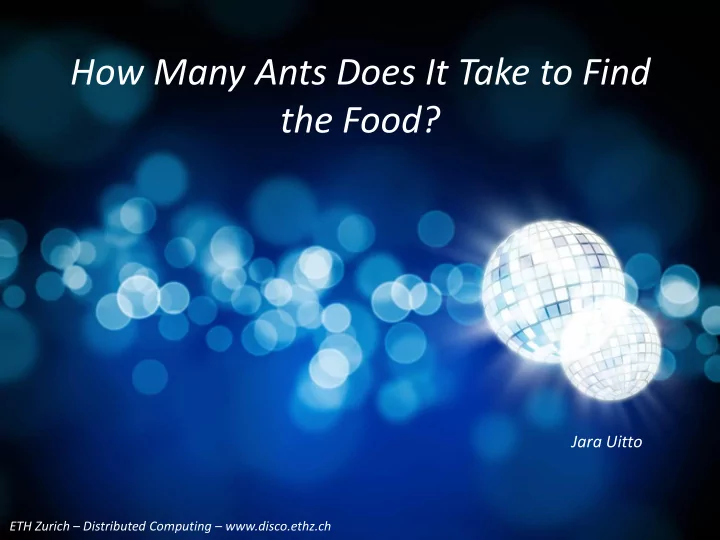

How Many Ants Does It Take to Find the Food? Jara Uitto ETH Zurich – Distributed Computing – www.disco.ethz.ch
Ants Nearby Treasure Search • Introduced by Feinerman, Korman, Lotker and Sereni [PODC 2012]. • 𝑜 mobile agents, controlled by Turing machines, search for a treasure. • Communication not allowed.
Model • Infinite integer grid. • Each ant initially located in the origin.
Model • Adversarially hidden treasure/food. • (Manhattan) distance to treasure is 𝐸 .
Ants Nearby Treasure Search • How many rounds until the treasure is found? • We study the number of ants needed to find the treasure at all.
Model
Model
Model • One Turing Machine is enough. No communication needed. =
Model • Ants are controlled by (randomized) finite state machines. • Communicate by sensing the states of nearby ants. • Run-time studied by Emek, Langner, Uitto and Wattenhofer [ICALP2014].
Model • Synchrony vs. Asynchrony • A deterministic protocol?
Model 1 • Individual algorithm for each ant. 2 • An algorithm works 3 correctly if the ants find the treasure in expected finite time.
Deterministic + Asynchronous
Triangle Search
Triangle Search
Triangle Search
Triangle Search
Triangle Search
Triangle Search
Triangle Search
Triangle Search
Triangle Search
Triangle Search
Triangle Search
Triangle Search
Triangle Search
Triangle Search
Triangle Search
Triangle Search
Triangle Search
Triangle Search
Triangle Search
Triangle Search
Triangle Search
Triangle Search
Triangle Search
Triangle Search
Triangle Search
Synchronization? • Can we perform better if the ants have a common sense of time?
Rectangle Search
Rectangle Search
Rectangle Search
Rectangle Search
Rectangle Search
Rectangle Search
Rectangle Search
Rectangle Search
Rectangle Search
Rectangle Search
Rectangle Search
Rectangle Search
Rectangle Search
Rectangle Search
Rectangle Search
Rectangle Search
Rectangle Search
Rectangle Search
Rectangle Search
Randomization • How about random coin tosses?
Geometric Search
Geometric Search NE
Geometric Search NE 1
Geometric Search NE 11
Geometric Search NE 111
Geometric Search NE 1110
Geometric Search NE 11101
Geometric Search NE 111011
Geometric Search NE 1110110
Geometric Search NE 1110110
Geometric Search NE 1110110
Geometric Search NE 1110110
Geometric Search NE 1110110
Geometric Search NE 1110110
Geometric Search
Run-Time • For every search 𝑗 , we have a probability of at 1 4 ∙ 2 −(𝐸+1) to find the treasure. least A i = • Let 𝐶 𝑗 be the event that the treasure is not found during any search 𝑘 < 𝑗 .
Run-Time • Let 𝑈 be the total time required. ∞ • 𝐹 𝑈 ≤ 𝑄(𝐵 𝑗+1 ∙ 𝐶 𝑗 ) (𝑃 𝑗 + 𝑃(𝐸)) . 𝑗=1 𝑗 . • 𝑄 𝐵 𝑗+1 ∙ 𝐶 𝑗 ≤ 2 − 𝐸+3 ∙ 1 − 2 − 𝐸+3 1 − 2 −(𝐸+3) 𝑗 𝑃 𝑗 + 𝑃(𝐸) • 𝐹 𝑈 ≤ 2 − 𝐸+3 ∞ = 𝑗=1 𝑃 2 𝐸 .
Lower Bounds? • Can we do better? In the deterministic and synchronous case, the answer is no. • Let us start with showing that one ant is not enough.
One Ant • A finite state machine repeats its behavior.
One Ant q
One Ant q q
One Ant q q q
One Ant 𝑑 A band of constant width
One Ant • One ant can only discover a band of constant width. • How about two ants?
Two Ants • Let 𝑢 be the time of the last meeting. • Both agents (alone) discover a band after 𝑢 .
Two Ants • Lemma: The ants meet infinitely often in some pair of states (𝑟, 𝑟 ′ ) . • Observation: the time between two such meetings is bounded by a constant.
Two Ants (𝑟, 𝑟 ′ )
Two Ants (𝑟, 𝑟 ′ ) (𝑟, 𝑟 ′ )
Two Ants (𝑟, 𝑟 ′ ) (𝑟, 𝑟 ′ ) (𝑟, 𝑟 ′ )
Two Ants (𝑟, 𝑟 ′ ) (𝑟, 𝑟 ′ ) (𝑟, 𝑟 ′ )
Two Ants (𝑟, 𝑟 ′ ) (𝑟, 𝑟 ′ ) (𝑟, 𝑟 ′ ) 𝑑′ • Two deterministic ants can only discover a band of constant width. • Two deterministic ants cannot find the food.
Conclusion • Three asynchronous ants? • Two randomized ants?
Conclusion
Questions? Thanks to my co-authors Yuval Emek, Tobias Langner, David Stolz and Roger Wattenhofer
Recommend
More recommend